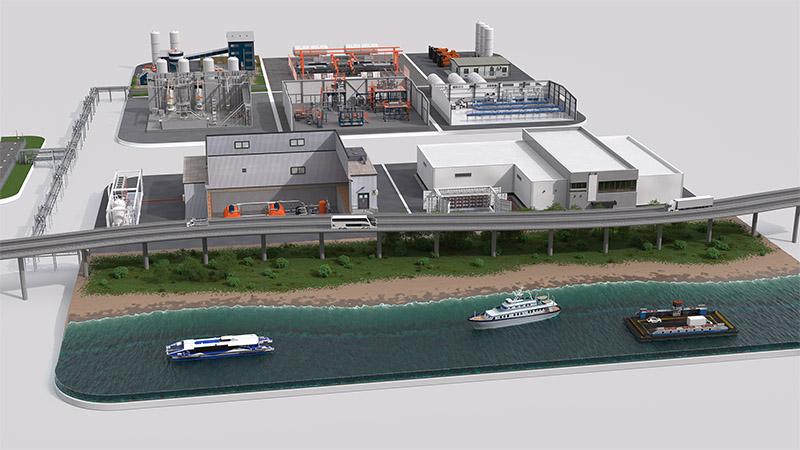How hydrogen and fuel cells can drive the green transition in shipping


With decarbonization high on the agenda in the maritime industry, hydrogen and fuel cells have an important role to play in driving the green transition of shipping. Esteemed industry expert Mikko Niini gives us his views on the challenges that need to be overcome and the promise that hydrogen holds for this vital industrial sector.
Shipping is one of the most energy efficient modes of transport and plays an essential role in global trade, transporting around 80% of goods by volume (Review of Maritime Transport 2023, United Nations Conference in Trade and Development). On the other hand, it is also a significant contributor to global greenhouse gas emissions, responsible for close to 3% of emissions caused by human activities.
As such, the maritime industry is under pressure to decarbonize. The International Maritime Organization (IMO) revised its Greenhouse Gas Strategy in 2023, setting targets to reduce GHG emissions by at least 20% by 2030 compared to 2008, by at least 70% by 2040 compared to 2008, and achieving net zero GHG emissions from international shipping by 2050.
The EU is pushing shipping hard, for example through the inclusion of shipping in the EU Emissions Trading System from the start of 2024. Ship owners and operators are facing great challenges in terms of deciding what alternative fuels and energy saving technologies they should adopt to achieve their own decarbonization targets and comply with increasingly strict national and international regulations as well as the Paris Agreement (COP21) goals.
The challenges of using hydrogen in shipping
Hydrogen has been used for decades in industrial processes, including in oil refining and metallurgical processes. It is also used in ammonia and methanol production – both fuels that are realistic alternatives to traditional fossil fuels in the maritime industry. One of the biggest challenges facing hydrogen today is that most of it is still produced using fossil fuels like natural gas. Furthermore, there are still no formally established rules and regulations on the use of hydrogen as a fuel for shipping, and the IMO’s progress on this issue has been slow.
Another challenge is that using hydrogen directly as a fuel would require a lot more space on board a ship compared to marine gas oil. It can be stored as a liquid below -253°C, but this requires a lot of energy and specialist storage systems. Hydrogen also brings its own set of unique safety challenges as it is highly explosive.
There is also the issue of fuel infrastructure. For hydrogen to play its part in shipping’s green transition there needs to be the infrastructure to support the distribution, storage, and supply of hydrogen as a fuel. Right now, this does not exist. There are plenty of initiatives on paper, but we cannot expect major developments in the shipping industry before classification societies, governments, and suppliers have done their part.
Norway leading the way in maritime hydrogen applications
Despite these challenges, countries like Norway are driving the adoption of hydrogen as a fuel for shipping, with extensive technology development and government support programs in place. Norway is leading the way because its government sees hydrogen – and green hydrogen in particular – as essential to achieving net-zero emissions by 2050. It is also a world leader in terms of shipping in general.
The MF Hydra ferry, the world’s first ferry to run on liquid hydrogen, is the result of collaboration between several companies. The ship uses polymer electrolyte membrane (PEM) fuel cells. In 2024 a Norwegian yard secured an order to build the two hydrogen powered ferries for the three-and-a-half hour Bodø–Lofoten route that Torghatten Nord won the contract for in 2022.
In addition to Norway, Japan is also a forerunner in the use of hydrogen for maritime applications. If other countries are to follow suit, regulatory developments relating to the use of hydrogen in shipping must be sped up. The adoption of the International Code of Safety for Ships using Gases or other Low-flashpoint Fuels (IGF Code) in 2017 was an important step, because it enables a specifically defined “Alternative Design Approach” that can be used for approving hydrogen fuel storage and fuel supply systems.
Fuel cell systems in the maritime environment
Fuel cells are more efficient than combustion engines and gas turbines, and because they are simple constructions with few moving parts, they are also quiet and reliable. They show great promise in terms of making it possible to use hydrogen as fuel in ships with electric propulsion. There are several marine projects using PEM fuel cells, and ABB is one of the leaders in this field, with a modular fuel cell solution that can be used in combination with batteries or engines on board ships.
The use of fuel cells in maritime applications is still in its infancy, but much like other technologies we will see rapid development and scaling up as companies and research institutions pool their knowledge and resources. The wind power industry is a good example of how rapid the pace of change can be. The first wave of offshore wind farms saw turbines with capacities around 2–3 MW, but in the latest projects there are turbines with capacities around six times that, at 15–20 MW.
Fuel cells will be a hugely important part of the maritime industry’s green transition with regard to electric and hybrid vessels in particular, which are growing in popularity. Fully electric vessels already exist on shorter, regular ferry routes, while hybrid ships are rapidly becoming the norm in the RoPax ferry segment.
Rapid development of regulations and infrastructure is critical
The maritime industry is already firmly on its journey towards decarbonization and the adoption of alternative fuels like hydrogen. Working together with regulators and governments, the next critical step is to speed up the development of regulations, safety codes, and infrastructure that will enable the wider and more rapid adoption of hydrogen as an energy source.
About the author

Mikko Niini is CEO of his own consultancy company, Vientistrategit Oy, Senior Advisor for Gaia Consulting, and Chair of The Finnish Maritime Association. Prior to his formal retirement in 2014 he was CEO of Aker Arctic Technology.
Mikko’s previous roles include leading management positions at various shipyards over the past 30 years. He has served as Chairman of the Board at both tanker asset management company Navidom Ltd and Rauma Marine Constructions Ltd. He has also served as a board member for ESL Shipping, Nemarc Shipping Corporation, ZAO Arctic Shipping Service, and Troms Offshore ASA, among others.
Get more fuel cell related insights
Get immediate access to presentation "Fuel cell R&D – Future trends, drivers and applications" for further insights from our Senior Strategy & Business Development Manager Anu Pulkkinen. Find also useful humidity measurement resources for fuel cell testing!